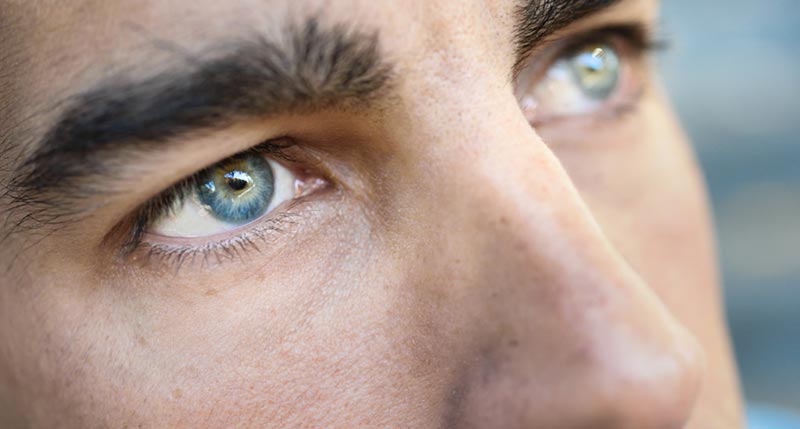What You Need to Know About Eye Floaters
Have you ever looked up at a bright blue sky, a blank piece of paper, or a plain white wall and realized that you’re seeing strange knobby strings, cobwebs, or dark spots floating around in your field of vision? And because you’re curious about these “squiggles,” you try to track them visually, only to see them quickly dart away or drift slowly out of your visual field. It’s a game of “Catch Me If You Can” that you will never win!
Those little squiggles are called eye floaters or myodesopsias, and nearly everyone has them – or one day will have them. Most people get them around age 50, but some patients may get them as young as 35.
What Causes Eye Floaters
- Age-related eye changes – Most eye floaters are caused by age-related changes in the thickness of the vitreous — the jelly-like substance between the lens and retina that helps the eye maintain its round shape. Vitreous is made primarily of water, collagen, and hyaluronan (a type of carbohydrate). As you age, that jelly liquefies, contracts, and pulls away from the inside surface of the eyeball. As the vitreous changes, collagen fibers form clumps and strings within the vitreous. As they move in front of the center of the retina, they cast tiny shadows, which we see as floaters. That type of floater is normal and doesn’t mean that your eyes aren’t healthy. You may notice floaters in one eye and then later in the other eye — but not usually in both eyes at the same time. That is because your eyes don’t age at the exact time or in the exact way.
- Inflammation inside of the eye – Inflammation in the eye (uveitis) is linked to autoimmune disorders and inflammatory disease; such medical conditions can cause floaters in the vitreous.
- Bleeding in the eye – Retinal detachments and tears, diabetes, hypertension, blocked blood vessels, and injury can cause blood cells in the vitreous that you see as floaters.
- Retinal tear – If the contracting vitreous pulls on the retina with enough force, the retina can tear. Without treatment, it can separate from the back of the eye, leading to retinal detachment and permanent vision loss. A retinal detachment is a sight-threatening condition that requires emergency medical attention! If you suspect you have a retinal detachment, call your optometrist or seek medical help at an emergency room.
- Eye surgeries and eye medication – Laser surgery can lead to temporary inflammation, and floaters can form after the laser disturbs the vitreous. Also, some medications that are injected into the vitreous can cause air bubbles to form, and these are seen as shadows or floaters until the eye absorbs them.
Risk Factors for Eye Floaters
- Being over 50 years of age
- Family history of retinal tears or detachment
- History of eye inflammation (uveitis)
- Being nearsighted (difficulty seeing things in the distance)
- Cataract surgery
How Will My Optometrist Evaluate Eye Floaters?
During your eye exam, your optometrist will dilate your eyes to get a clear look at the retina in the back of your eye. Your eye doctor can see your floaters during this part of your exam. It’s important to have regular eye exams to enable your doctor to keep track of how your vitreous is changing over time.
Your eye doctor may ask:
- When did you first notice the eye floaters?
- Have they increased in number or stayed about the same?
- What do your floaters look like?
- Do you see numerous floaters?
- Do you see floaters all the time?
- Do you ever see flashes of light?
- Have you had eye surgeries in the past?
- Do you see shadows on the side of your vision, or does it seem that there is a curtain in front of your eyes?
- Do you have diabetes, an autoimmune disease, or family history of retinal problems?
There is no “cure” for floaters, and you can’t prevent them, but you can reduce the risk of floaters by managing chronic illnesses like diabetes and high blood pressure.
Retinal Detachment Requires Emergency Medical Attention
Since eye floaters are common, you may be wondering, “What changes do I need to be aware of, and when do I need to contact my optometrist about them?”
Call your optometrist immediately if you notice:
- A blurry or grey area that blocks part of your vision
- Flashes of light in the eye along with the floaters
- A sudden “shower” of new floaters
- Darkness in your side vision that causes peripheral vision loss
- The sensation that a dark curtain has closed on part of your visual field
The symptoms listed above may indicate retinal detachment. The severity of symptoms often parallels the severity of the retinal detachment. Time is critical with a retinal detachment — it needs to be repaired urgently or blood flow to the retina can be lost along with the vision in that eye. Call your optometrist immediately, or go to the emergency room to seek medical help.
How to Live with Eye Floaters
Eye floaters don’t usually require treatment and are just a normal part of aging. However, any changes to your vision should by assessed by your optometrist.
Call our office today to schedule your annual comprehensive eye exam. Let our eyecare team answer your questions about eye floaters and keep a close watch on those annoying (but permanent) squiggles, spots, and specks so you can continue enjoying good vision throughout your lifetime.






